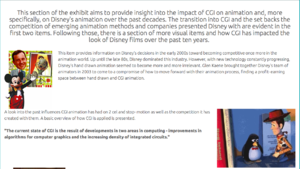Kate Gordon
From DigitalRhetoricCollaborative
| (9 intermediate revisions not shown.) | |||
| Line 3: | Line 3: | ||
==Overview== | ==Overview== | ||
| - | Curation in [http://en.wikipedia.org/wiki/Digital_rhetoric digital rhetoric] is | + | Curation in [http://en.wikipedia.org/wiki/Digital_rhetoric digital rhetoric] is the process involving the compiling of information for the purpose of constructing a text in order to present a specific argument. Curation at a basic level, involves the selection,organization, and presentation of information accessed from archives. With such a vast amount of data available across a wide range of media, the opportunities of curation are reimagined under the scope of the digital world. |
| - | "Cathy Davidson explains that the first wave of humanities computing brought with it the onset of digital curation—a process that made archival materials widely available on the Web and “transformed how we do research and who can do | + | "Cathy Davidson explains that the first wave of humanities computing brought with it the onset of digital curation—a process that made archival materials widely available on the Web and “transformed how we do research and who can do it." (709) <ref>http://www.ncte.org/library/NCTEFiles/Resources/Journals/CE/0762-nov2013/CE0762Seizing.pdf</ref> |
| + | |||
| + | ==Who curates?== | ||
| + | The digital age has made access to archives instantly available to anyone with wifi access, making it possible for anyone to create a text for the purpose of presenting an argument. | ||
| + | Traditionally, curators have fallen under the umbrellas of science, history, art, and many other scholarly subjects. <ref>http://mw2013.museumsandtheweb.com/paper/curating-the-digital-world-past-preconceptions-present-problems-possible-futures/</ref> Now these subjects are available in their multitude of archives to draw from when a digital curator sets out to compose a text. Websites and tools are now available and accessible to anyone with a basic knowledge of computers and have put tools in place to make it easy for someone to learn how to operate the website for the purpose of curation | ||
| + | ==What is a curated exhibit?== | ||
| + | [[Image:CGIExhib.png | thumb | 300px | alt=An exhibit done with the Omeka tool.]] | ||
| + | An exhibit is deliberately curated to form a message and is able to be accessed by the public. Digital Curation has access to incorporating various media into a text including: | ||
| + | ====Visual==== | ||
| + | *Photograph | ||
| + | *Video | ||
| + | ====Audio==== | ||
| + | *Music | ||
| + | *Sound Clips | ||
| - | + | ==Debates of digital curation== | |
| + | Todd Presner explains, although these new data-mining technologies may “threaten to overwhelm traditional approaches to knowledge,” they do “[allow] us to ask questions that weren’t previously possible." <ref>http://www.ncte.org/library/NCTEFiles/Resources/Journals/CE/0762-nov2013/CE0762Seizing.pdf</ref> | ||
| + | Activity Theory <ref>https://books.google.com/books?hl=en&lr=&id=e_UWDeEca0IC&oi=fnd&pg=PA49&dq=digital+rhetoric+curation&ots=aW8ctpqh-T&sig=niuVJNGiGQ2iS9JONDDvBijF6XA#v=onepage&q=digital%20rhetoric%20curation&f=false</ref> | ||
| - | |||
| - | |||
| - | |||
| - | |||
| - | |||
| - | |||
| - | |||
| - | |||
| - | |||
| - | |||
| - | |||
| - | |||
| - | |||
| - | |||
| - | |||
| - | |||
| - | |||
| - | |||
==References== | ==References== | ||
Current revision
Contents |
[edit] Curation (Digital Rhetoric)
[edit] Overview
Curation in digital rhetoric is the process involving the compiling of information for the purpose of constructing a text in order to present a specific argument. Curation at a basic level, involves the selection,organization, and presentation of information accessed from archives. With such a vast amount of data available across a wide range of media, the opportunities of curation are reimagined under the scope of the digital world.
"Cathy Davidson explains that the first wave of humanities computing brought with it the onset of digital curation—a process that made archival materials widely available on the Web and “transformed how we do research and who can do it." (709) [1]
[edit] Who curates?
The digital age has made access to archives instantly available to anyone with wifi access, making it possible for anyone to create a text for the purpose of presenting an argument. Traditionally, curators have fallen under the umbrellas of science, history, art, and many other scholarly subjects. [2] Now these subjects are available in their multitude of archives to draw from when a digital curator sets out to compose a text. Websites and tools are now available and accessible to anyone with a basic knowledge of computers and have put tools in place to make it easy for someone to learn how to operate the website for the purpose of curation
[edit] What is a curated exhibit?
An exhibit is deliberately curated to form a message and is able to be accessed by the public. Digital Curation has access to incorporating various media into a text including:
[edit] Visual
- Photograph
- Video
[edit] Audio
- Music
- Sound Clips
[edit] Debates of digital curation
Todd Presner explains, although these new data-mining technologies may “threaten to overwhelm traditional approaches to knowledge,” they do “[allow] us to ask questions that weren’t previously possible." [3]
Activity Theory [4]
[edit] References
Resources
- ↑ http://www.ncte.org/library/NCTEFiles/Resources/Journals/CE/0762-nov2013/CE0762Seizing.pdf
- ↑ http://mw2013.museumsandtheweb.com/paper/curating-the-digital-world-past-preconceptions-present-problems-possible-futures/
- ↑ http://www.ncte.org/library/NCTEFiles/Resources/Journals/CE/0762-nov2013/CE0762Seizing.pdf
- ↑ https://books.google.com/books?hl=en&lr=&id=e_UWDeEca0IC&oi=fnd&pg=PA49&dq=digital+rhetoric+curation&ots=aW8ctpqh-T&sig=niuVJNGiGQ2iS9JONDDvBijF6XA#v=onepage&q=digital%20rhetoric%20curation&f=false

